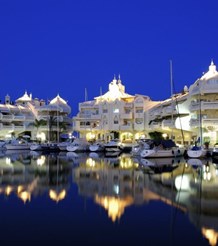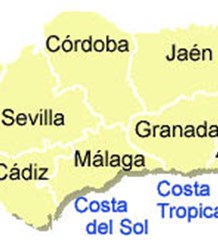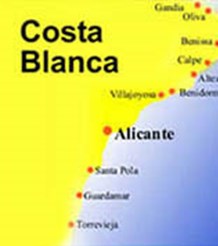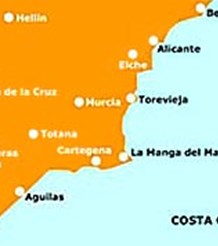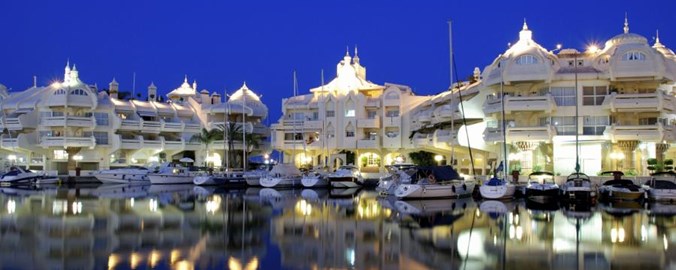
Costa del Sol Information
The Costa del Sol stretches some 300 km of coastline along the south of Spain from Gibraltar to Malaga. Use the links below to see information about specific regions.
- Benahavis Area Information
- Benalmadena Area Information
- Calahonda Area Information
- Elviria Area Information
- Estepona Area Information
- Fuengirola Area Information
- La Cala Area Information
- La Linea Area Information
- Malaga Area Information
- Manilva Area Information
- Marbella Area Information
- Mijas Area Information
- Puerto Banus Area Information
- San Pedro Area Information
- Sotogrande Area Information
- Torremolinos Area Information
The varied coastline of the Costa del Sol has diverse offerings; many long sandy beaches, coves half hidden among cliffs, marinas and fishing grounds. It is protected from cold north winds by the mountains and has a mild climate with sea breezes and scant rainfall. The vegetation is subtropical in character while oranges, lemons and olives grow in abundance. Away from the coast the scenery is largely mountainous and dotted with pretty, white Spanish villages, valleys and hillsides planted with orchards and spectacular views.
Málaga, the fifth largest city in Spain, is situated in the center of the Costa del Sol. Málaga has been influenced by the different cultures which have populated it since its beginning. Founded by the Phoenicians in the 7th century, it later became a Roman settlement. Afterwards, it was conquered by the Moors and finally re-conquered by the Christians in 1487. With such a varied history it is no surprise that the city contains a wealth of interesting features including fine gardens, a magnificent cathedral, the Alcazaba (an 11th century Moorish castle) and numerous museums and galleries. It is the birthplace of Picasso and his childhood home is a museum.
Each town along the Costa del Sol has its individual character depending on its history. Torremolinos, the first resort heading west from Malaga, was the pioneer for resorts in the area and many people erroneously associate it with its reputation of 20 or more years ago. Whilst it still has its discos and high rise apartment blocks, the old fisherman’s quarter has been developed into an area of wonderful shops and restaurants. The two main beaches, Bajondillo and La Carihuela, are renowned for their beauty.
Heading further west you arrive at Benalmadena Costa, a modern resort that has incorporated the older towns of Arroyo de la Miel and Benalmadena Pueblo. This area provides every facility for tourists, including one of the finest pleasure ports on the Mediterranean to a modern seaside area and, in Benalmadena Pueblo, a typical white Spanish village.
Along the coast is Fuengirola where the longest sea front promenade on the coast can be found. The old town centre with all its attractions has been preserved and is an area buzzing with life from bars and restaurants.
Mijas is a white village perched on the side of a mountain. It is famed for its donkey taxis and artist colonies. The town has spread down to the coast where it is known as Mijas Costa.
Marbella, playground of the rich and famous, was never a little fishing port but has always been a thriving trading town. Along with Puerto Banus and Estepona, further to the west, Marbella has been very successful in attracting upmarket guests to its exclusive developments, luxury hotels and five star shopping.
East of Malaga is less well developed with the main resort town being Nerja. This is a small town built on a ledge where the mountains meet the sea. Nerja is famed for its protected climate, clear air, caves and magnificent views over the sea. A series of musical concerts and ballets, with top artistes are held in the caves every year.
Travelling inland, the area is full of small white villages with narrow winding streets; each with its own quality and history. There are several areas of incredible natural beauty such as El Parque de los Alcornocales, a forest area populated with cork oaks and chestnuts. The two inland towns of Ronda and Antequera each have something special to offer visitors. Ronda is a particular favourite, with its spectacular gorge, ancient bullring and magnificent mansions.
The Costa Del Sol with its numerous golf courses has been given the alternative name of Costa Del Golf and is a must for golfers who will find their every need and standard catered for.
Finally, the Costa Del Sol is acclaimed for its way of life, with plenty of small bars to relax in, superb food, wonderful people and its ferias or fairs. Every town and village has at least one feria in celebration of its patron saint. These usually last a week and are an excuse for residents and visitors alike to enjoy themselves from dusk to dawn.
Benahavis Area Information
Past San Pedro de Alcantara, at the Guadalmina golf course, turn off the N340 coast road and drive inland for 7 kilometres and you will come to Benahavis.
Three rivers, each of which forms its own valley, shape the municipality of Benahavis, making it an area of superb valleys and countryside. It is one of the most mountainous areas of the Western Costa del Sol with a richly diverse landscape and some truly admirable places to visit. This charming white village stands 160 metres above sea level.
Although the mass construction on the coast has affected Benahavis to a certain extent, 70% of the municipality has been declared an area of special scientific interest and is therefore protected.
Without doubt, one of the most important aspects of Benahavis today is its cuisine. The village is known as the "dining room of the Costa del Sol" owing to the large number of restaurants of every nationality that flourish in the centre. A gastronomic festival is usually held in June, and on this day restaurants offer the best from their menus at the entrance to the locality.
Benahavis has a thriving artist’s colony and you will find a broad spectrum of work on offer. There are several artists and sculptors of international stature who live in the village centre and exhibit and sell their work here.
The village fair is held from 11 to 15 August. During this time there are well-attended activities culminating with a Rocío mass and a procession.
The History of Benahavis
The first nucleus of a village was formed during the Arabic era. It seems to have been founded in the late eleventh century and in the shadow of the Montemayor castle. This fortress has witnessed the entire history of the village, from the clashes among the Muslims themselves until their confrontations with the Christians. Much later Benahavis was the scene of a struggle between the Spanish and French during the Napoleonic invasion in the early nineteenth century.
For many centuries Benahavis formed part of Marbella until in 1572, after many protests by locals, Philip II granted independence to the municipality.
Benalmadena Area Information
The jewel in Benalmadena’s crown is its leisure harbour. With over 1000 berths and more being built, it is rated as one of the best harbours in the world.
Arroyo de la Miel, part of Benalmadena, has become a residential and commercial centre. It is here that most of the new residential building is taking place which consists of a mixture of new villas, townhouses and apartment blocks.
In the thriving shopping area, almost anything can be bought and an industrial area is tucked away out of sight of the town centre. Arroyo has become a popular place for British ex-pats to live and at times it almost resembles an English market town. Walking along the street, one is as likely to hear as much English being spoken as Spanish.
Arroyo boasts the train station, linking it to Malaga and Fuengirola, the cable car and Tivoli World. Because of these attractions, many people visit Benalmadena but do not realise that further up the hill there is the secret of Benalmadena Pueblo.
Benalmadena Pueblo is a delightful little town and is full of narrow, winding streets, flower bedecked balconies and whitewashed houses, making it a beautiful example of real Spain.
Benalmadena Marina is rightly known as the Puerto Deportivo de Benalmadena (Sports Harbour of Benalmadena). The port has won awards as the best port on the Mediterranean. Today’s port started life some 35 years ago as a simple basin used primarily by fishing boats. Much of the building making up the port is situated on reclaimed land and the first island was constructed about 15 years ago. There are 3 separate islands of apartments. Some of the current owners include Antonio Banderas, Ryan Giggs and Teddy Sheringham. The centre island, where Antonio Banderas has his apartment, is named after his wife, Melanie Griffiths.
Over the last few years the area around the port has been developed into a leisure complex bursting with bars, restaurants and shops. There is also a separate area to the left of the main port that is famous for its music bars and discos.
There are over 1,000 boats moored in the harbour and some of the famous owners include Rod Stewart, Michael Schumacher and King Farouk.
Calahonda Area Information
Calahonda is positioned between Marbella and Fuengirola and only 20 minutes from the international airport at Malaga. Sitio de Calahonda is one of the largest and most prestigious developments of the Costa del Sol. Since its foundation in 1963, Sitio de Calahonda has grown into a marvellous residential centre with excellent shopping and entertainment facilities.
For golf lovers, the Costa del Sol is well served with courses and Calahonda is within easy reach of many of these courses.
Calahonda Facilities
- 3 medical centres open 24 hours.
- 3 commercial centres with decoration stores, sports, souvenirs, ironworks etc.
- Banks - Solbank, BBV, Banco Atlantico, La Caixa, Barclays, Santander, Deutsche.
- 45 cafeterias, bars and restaurants.
- 3 supermarkets.
- 1 golf course with 9 short holes.
- 3 golf courses under construction.
- Numerous lawyers and accountants.
- Office of the Department of foreigners of the City Council of Mijas.
- Language Schools.
- Car rental companies.
- Garages.
Elviria Area Information
Elviria is located between Marbella and Calahonda, about 15 minutes east of Marbella's city centre and is only 50 kilometres from Malaga international airport. It is well supplied with services, amenities and entertainment facilities.
Many homes on this coastal development are within easy walking distance of the beach. Also conveniently near are the Santa Maria and Santa Clara golf courses with their respective clubs. There are two more courses, Golf Club Marbella and Golf Rio Real, only a short drive away. The El Casco Tennis Club, with its high quality facilities, is another attraction of Elviria. The smart marina at Puerto Cabopino has convenient mooring for Elviria residents.
Health services are also nearby, in the form of one of Malaga's most prestigious hospitals, Hospital Costa del Sol. Also on site is the English International School for primary and secondary students.
The village itself has a genuine heart, complete with town hall, post office, schools, bars, restaurants and shopping centres. It is a few hundred metres from Golden Beach, from which you can walk to Los Monteros and on to Marbella to the west, or to the charming Puerto Cabopino to the east.
Among the many attractions nearby: Marbella has a beautiful old town where you will find the Plaza de Naranjos (orange square) with superb dining facilities. Puerto Banus is a people watching paradise where you can also enjoy looking at luxury yachts and shopping at the stylish boutiques.
Estepona Area Information
With a population of 37,000, Estepona bustles with life, especially in the atmospheric old town and centre. All the tourist facilities are here, including hotels, restaurants, leisure and cultural activities and shops.
The numerous street cafes and tapas bars serve traditional Spanish delicacies and the steep, cobbled, narrow streets seem more suited to horses than cars. You will find many unusual shops and bodegas in Estepona, in places where you would least expect them. They are very inviting, very friendly and reasonably priced.
The city has become a tourist center owing to its magnificent beaches and the abundance of services and facilities for enjoying your holidays.
Estepona’s origin is attributed to the Phoenicians and its existence is confirmed in documents from Roman times. The Arab settlers gave the town the name of Estebbuna.
Estepona has a wonderful marina, Estepona Puerto Deportivo, with capacity for 900 boats. It is located near the town center and as night falls it transforms into a crowded and enjoyable nightspot.
Estepona has several museums to visit including the Tool Museum, which houses all kinds of implements which were regularly used in fishing and agricultural works.
Places of Interest in Estepona
- Clock Square
- Flowers Square
- Remedios Church , 18th century
- Clock Tower XV century
- Almenara Tower
- The remains of the castle walls, SV century
- The remains of the Nicio Castle
- Bullring
- Estepona Lighthouse 1861
- The Marina
- Marqués de Mondéjar Palace and de la Borrega House
- The Tool Museum,
- The Dolls Museum
- Sea Museum
The surroundings of Estepona are propitious for the practice of adventure and mountain sports. In addition it has an Escuela de Arte Ecuestre founded in 1998 and located at 800 metres from the beach and not far from Sierra Bermeja. Selwo, Costa del Sol, is situated here which is a big nature park where everybody will discover a lot of animals from the five continents, living in semi-freedom.
Festivities
A good time to visit Estepona is during the Fiestas Mayores (3-10 July) when the summer fair is held. During the Virgen del Carmen religious celebration (16 July) the Virgin is taken out of the fisherman’s church to bless the sea.
- The major feria is from 3rd –10th July.
- 16th July Virgen del Carmen.
- 23rd June San Juan Night on the beach with bonfires and fireworks.
- 15 May is the San Isidro fair. San Isidro el Labrador is the patron saint of Estepona.
Typical Dishes
Estepona cuisine celebrates the two sides of Estepona - agriculture and the sea. There is the hearty country soup, chilled tomato and garlic soup known as gazpacho from the land and barbecued sardines from the sea, as well as the renowned Malaguenian fish fry-ups, or frituras, and fish baked in salt. Another typical sea dish is sardines baked in tiles, sardinas a la teja.
Fuengirola Area Information
Fuengirola is only twenty minutes from Malaga airport and is probably the most popular tourist resort on the Costa del Sol. A local train provides easy access to popular nearby resorts such as Torreblanca, Arroyo de la Miel and Torremolinos.
The Romans called the city "Suel" after a star that can be seen clearly from the castle. The castle is the town’s symbol and stands on a hill commanding an impressive view over Fuengirola.
Fuengirola is probably most famous for its five miles of sandy beaches and wide promenade. High rise hotels and blocks of residential apartments overlook the beaches and have magnificent views of the Mediterranean and the sweeping coastline. The beaches at Los Boliches, Las Gaviotas and Torreblanca have a European blue flag.
A recent landscaping drive by the local municipality has created beautiful gardens with palm trees, interspersed with colourful flowerbeds.
Due to the cosmopolitan nature of Fuengirola a wide choice of entertainment and restaurants is available, ranging from traditional Andalucian tapas (bar snacks) and shellfish dishes to British favourites such as bangers and mash. Fuengirola is particularly popular with Spanish nationals, many of whom own summer apartments here.
Fuengirola is an excellent shopping center with a wide selection of supermarkets and competitively priced shops. There are several well-known department stores within easy reach of the town and a street market on Tuesdays.
Annual fiestas include the Feast of the Virgin del Carmen in July when local fishermen carry an effigy of the Virgin out to sea, while the colourful feria takes place in October. This is the time when the town really comes to life with Flamenco, fino (dry sherry) and fun, which carries on to the early hours and lasts for an entire week.
Buying property in Fuengirola is very popular these days due to the excellent public transport links, miles of beautiful sandy beaches and the amazing rental potential it offers. It sits only a 20 minute drive from Málaga Airport, one of the busiest airports in Europe and is also close to the resorts of Benalmadena, Marbella and Puerto Banus.
La Cala Area Information
La Cala is a mere 25 minutes from the international airport at Malaga. A newly built promenade runs the length of its well-maintained blue flag beach.
An excellent tennis club and a bowling green are amongst the variety of sports clubs in La Cala. There is an abundant supply of shops, bars and restaurants catering for all tastes including Spanish, Indian, Chinese, Thai and English.
On the outskirts of La Cala lies the Hippodromo (race course) and in July and August horseracing is held on Saturday night from 10pm to 2am. In the winter, racing is on Sunday from 12am to 2pm lunchtime. At the racecourse there is a vast selection of bars and restaurants, some with live music. An evening at the races is an excellent night out for the whole family.
La Cala also boasts fine golf courses set in picturesque surroundings, which are popular all year round.
La Cala has a lot for the kids to do too – it is close to Fuengirola Zoo and the Sea Life Centre and Tivoli World in Benalmadena. Altogether it is an ideal place for an all-round family holiday.
La Linea Area Information
La Línea is situated on the shore of the Bay of Algeciras on a sandy plain that runs from the Sierra Carbonera to Gibraltar. It has the reputation of being one of the sunniest towns in Spain with almost 3,000 hours of sunshine while, thanks to the 74% humidity and constant cool breezes, it does not to suffer from extreme heat.
In recent years, the town has been developed and reformed, and is starting to take its place as one of the region's most popular tourist centres.
The name La Línea comes from the line of fortifications built by Philip V when Gibraltar was ceded to the English. The ruins of the Santa Barbara fortress, one of the last of Philip V's fortifications, were destroyed by the British during the Peninsular War (1804-14) to prevent them falling into the hands of the French. On the Playa de Levante (eastern beach) there is a watchtower, which dates back to 1630.
The popular La Atunara area, close to the fishing quarter, small harbour and church is where the town originally developed. Much of it is preserved and today it is known for the many bars and restaurants near the beach, specialising in fresh fish dishes.
The Wednesday outdoor market is found along the Avenida Principe. Here you will find soft furnishings, rustic furniture, clothing and many other items are on sale at very reasonable prices. La Linea has a compact shopping area, situated between the Calle Real and the Plaza Cruz Herrara. In this Plaza that you will find the Museo del Istmo, located in the old military headquarters
The La Linea bullring attracts large crowds, and there is a municipal theatre where many international companies have performed. There is a museum of bullfighting too, several large churches and the Princess Sofia park with a playground for the children.
Alcaidesa is a development within the municipality of La Línea. In Alacaidesa you will find a mixture of permanent residents and holidaymakers. The area of Alcaidesa covers approximately four square kilometres and stretches from the motorway down to the beach front. Here you will find superb housing developments with outstanding views towards the Mediterranean. It is also home to a links golf course where players take advantage of the year round mild climate.
Malaga Area Information
As the capital city of the Costa del Sol, Malaga is a thriving Mediterranean port. Pheonician traders established the city in the 8th century.
In the bustling city of Malaga, the old and the new meet on Marques de Larios, Plaza de la Constitución and Calle de Granada. These form the backbone of the shopping area and the thriving nightlife. The narrow side streets are an intriguing maze of alleys crammed with tapas bars and bodegas - old-fashioned wine shops brimming with casks. Here you can sample the local sweet wine, which is similar to Port. At weekends the area is full of young people enjoying the thriving nightlife in the city's many bars, bar de copas (wine bars), or nightclubs. Locals often do not go out until midnight and will continue partying until the morning light, stopping for breakfast on their way home.
At Easter the city comes alive for Semana Santa (Holy Week) and the streets are packed until the early hours as the night air is filled with music from the processions. Large flotillas called tronos (throwns) with scenes of the crucifixion are carried through the town. The Semana Santa celebrations are among the largest in Spain and draw visitors from all over the world.
The summer fair (Malaga Feria) is the city's other major annual event. Held every August it is claimed to be the second largest fair in Europe. For one week city folk and visitors celebrate in traditional Andalusian style. The celebrations start around midday in the main pedestrian street of Calle Larios and continue until 6.00 or 7.00 in the evening. There is plenty to eat and drink and the streets are full of people enjoying themselves. Once the partying subsides it's time for a quick rest until 11.00 or midnight and then on to the fair ground outside the city centre. The fair has special temporary bars called Casetas, and most put on shows of Flamenco music and dancing.
Picasso spent the first 14 years of his life in Malaga before moving to Barcelona and the airport is named after him. Recently his daughter-in-law donated many of Picasso’s artworks to the city, which has built a museum dedicated to him. The house where he lived in Plaza de la Merced is a popular tourist attraction, although it is no longer open to the public.
Manilva Area Information
Manilva is a small, traditional town built on a hilltop overlooking the coast. It was part of the municipality of Casares until 1797. It covers an area of 35.20 sq. kms and is 128 metres above sea level with an average temperature of 18 degrees.
Fishing and agriculture have been the main occupations of its inhabitants throughout its history and the muscatel grapes on the vines covering the hill slopes are famous for the delicious wine made from them.
Manilva, has are three districts: itself, San Luis de Sabinillas and El Castillo de la Duquesa. There are many residential communities scattered through the area, which are home to the cosmopolitan community that has settled in the district. The setting is magnificent, with the splendid Sierra Bermeja Mountains in the background and views to Gibraltar and Africa in the foreground.
La Duquesa Golf Club, the yacht marina and the Magic Hills residential sport complex make this a significant tourist destination. Local cuisine is mainly based on the great variety of fish that is available whilst its tomato soup is justly famous.
Castillo de la Duquesa in nearby Sabinillas is a castle built to defend the town from pirates, who for centuries ravaged the coastal area.
Manilva has a fascinating history that dates back to Roman times and today you can visit the remarkably well-preserved Roman sulphur baths. Your skin will feel silky when you get out. Aside from the Romans, many civilizations and cultures have made Manilva their home, including the Phoenician and the Moors. In 1528, Carlos V erected a watchtower called the Salto de laMora to protect the 50 or 60 inhabitants at that time. The consequence of this was the area became more attractive and the agricultural industry slowly expanded. In July 1650 the names Manilva and Sabinillas were established.
One of the most interesting historical monuments apart from the Roman Baths is the Church of Santa Ana, which dates back to the late 17th Century. Shortly afterwards the Castle of Duquesa was built, but wasn’t completed until the 18th century.
Manilva boasts several wines unique to the area, both dry and sweet. There are also well-known fish restaurants and chiringuitos (beach bars) renowned for their excellent seafood and fish dishes.
The traditional fiestas, include carnaval in February - a time of fun and feasting before the onset of the austere lent. The Romeria de Nuestra Senora de Fátima takes place in June and the night of San Juan is celebrated on 24th June. In addition, on the 16th July the blessing of the Virgen del Carmen is sought when she is taken to dip her feet into the sea. On the 26th July Santa Ana, the patron saint of the district is celebrated with a feria.
Manilva is an intriguing village that is well worth a visit as it has much to offer the visitor in the way of traditional Andalucian charm.
Marbella Area Information
Located in the region of Andalucia on the Costa del Sol, Marbella is Spain’s answer to St Tropez and here, as in its French counterpart, you will find the rich and famous.
Neolithic and Palaeolithic remains have been found in Marbella. It was a Phoenician settlement and later the Romans arrived. They called the town Salduba – city of salt.
The Moors arrived in this part of Southern Spain in the first decade of the 6th century and they called the town Marbil-la. The castle walls that are found in parts of the town date from this time.
When Prince Alfonso de Hohenlohe’s car broke down near the town in the 1940’s he realised what a gem the place was and decided to exploit its special qualities. In 1954 he opened the hotel Marbella Club. Then the rich and famous flocked to the resort and Marbella’s name became synonymous with luxury and pleasure. Thanks to its climate and golf courses, in a mere 50 years, a sleepy fishing village has become and international hotspot.
The focal point is the Old Town, which is still partially surrounded by the ruins of the old Arab wall. Orange Square with its ancient stately buildings, tall trees and exotic tropical plants is the nerve knot of the town and here you will find shops and restaurants to suit all tastes.
The cobblestone streets wind through alleys, past immaculate facades, and balconies decorated with flowerboxes bursting with geraniums and carnations. There are tiny, typically Andalucian squares and interesting nooks and crannies, such as the Balcón de la Virgen (Balcony of the Virgin Mary) set in the window of an old whitewashed house that houses a restaurant.
Marbella is also famous for its wonderful beaches and its marina, where luxurious yachts arrive from all over the world. It has beautiful boutiques, luxurious hotels, shopping centres and a vibrant nightlife. It is also a very popular place for luxury long term rental property.
Mijas Area Information
Mijas is one of the most famous pueblos blancos (white villages). Located at an altitude of 428 metres above sea level, it is set amongst pine forests and lush vegetation on the side of the Sierra de Mijas.
This municipality, like many others in the province of Málaga, has three centres of population: Mijas Pueblo, Las Lagunas and Cala de Mijas. The first of these is a classic whitewashed Andalusian village of Moorish origin that contains the monuments and the administrative centre. Most of the municipal services and part of the building developments are in Las Lagunas while La Cala de Mijas, within the coastal zone, is completely given over to residential and beach tourism.
Mijas has superb views over Fuengirola and the Mediterranean Sea. The area has become a favourite with artists and the narrow streets are filled with ceramics and craft shops and as well as cafes, bars and restaurants.
It is believed that Mijas was founded by the Turetanos, of the mysterious Tartessian Civilisation. The Romans developed a fortress on the site, which was conquered by the Moors in the 8th Century. In 1487 the town was taken by the Christian army and used as military headquarters during the years that followed.
During the Civil War Mijas was a Republican stronghold. It is rumoured that underneath the Iglesia Parroquial de la Inmaculada Concepción there are tunnels where the villagers hid from Franco’s army.
Puerto Banus Area Information
Puerto Banus is the place to ogle luxury yachts while sipping a drink at one of the many open air restaurants and bars. The setting is close to ideal with its impressive mountain backdrop and ocean views.
Since its inception some forty years ago, the port has steadily grown and now features a casino, commercial shopping centre, a Corte Ingles department store, marine observatory and a multi cinema with films shown in their original versions.
Nightlife buzzes at Puerto Banus with an extensive choice of al fresco bars, piano clubs and discos. During the day this is a window shopper’s dream with several world-renowned fashion houses featured here as well as smaller, interesting shops and boutiques for clothes and souvenirs.
There are regular boat trips, around the harbour and up the coast available from the central promenade. The pretty beach adjoining Puerto Banus is a European blue flag beach.
Every Saturday, near Puerto Banus around the bullring, a very popular street market takes place, where you can pick up all sorts of bargains.
San Pedro Area Information
Ten kilometres west from all the glitz and glamour of Marbella lies the village of San Pedro de Alcantara. This well situated town is only a short drive from the natural beauty of the Sierra de Ronda mountain range and 20 km from the fishing community of Estepona.
San Pedro was an ancient farming community, famous for sugar cane and today it is a refreshingly unspoilt pueblo with an appeal all of its own. Be sure to head for the central plaza with its gracious parish church and surrounding narrow streets packed with intriguing small shops, sidewalk cafes and bars. On Thursdays, visit the street market, a veritable bargain shopper’s paradise.
It is a pleasant walk from the town centre to the beachfront along the Avenida del Marques del Duero, an attractive wide avenue flanked by palm trees. The modern promenade is an ideal place for continuing your stroll with several excellent chiringuitos (beachside restaurants) specialising in fish dishes.
Visit Bora Bora if only for a drink at the bar - it is one of the best beach clubs on the coast with a superb restaurant and all the usual beach facilities. It is built in Polynesian style with thatched roofs and large wicker chairs.
History buffs will enjoy the Palaeochristian Basilica by the sea and the third century Roman Baths, Las Bovedas. The Church and Necropolis are located in the woods next to the Bora Bora Club on the seafront. A little further west along the beach, near Guadalmina, the restored remains of the Roman Baths are located. Check at the local tourist office for opening times.
San Pedro has the last summer feria (fair) in Andalucia, in the second week of October. Here you will meet your friends from all along the coast as they gather to say goodbye to the summer.
Sotogrande Area Information
The name Sotogrande comes from one of five farms bought by Alfredo Melian in 1962 at the request of Joseph McMicking who wished to create a luxurious residential development by the Mediterranean.
The reputation of Sotogrande and its appeal to so many nationalities lay initially in the natural beauty of the site. It has developed into a complete community with its own shops, schools, sports facilities, golf clubs, marina, banks, restaurants, hotels and bars.
Sotogrande is world famous for its sport - especially golf and polo. It boasts three golf courses, two of which are among the top five golf courses in Europe. Sotogrande was host to the Ryder Cup in 1997 and the 2002 Volvo Masters.
It is also one of the top venues in the world for polo and the only place in Europe where the sport is played throughout the year while during summer there are many tournaments played. The Santa Maria Club is the hub of Spanish polo and stages an international tournament each August. The club is in a magnificent setting and its fabulous facilities attract top players from all over the world.
Accommodation ranges from luxury hotels and villas in their own grounds to country and beach apartments with communal pools. From some of the beach apartments there are breathtaking views of the Straits of Gibraltar that are particularly beautiful at sunset in winter months.
The marina is the first main leisure harbour on entering the Mediterranean. Here there are waterside apartments with their own moorings. Walks can be enjoyed along the banks of the Guadiaro River which flows into the sea at Sotogrande, and you can visit hides from which migrating flamingos and other birds can be observed.
Torremolinos Area Information
Torremolinos has evolved over the last few years into an attractive and appealing resort noted for its clean sandy beaches, wide choice of hotels and restaurants. There is an unparalleled variety of entertainment, activities and nightlife available.
This town was at the heart of the tourist boom back in the 1980’s and it got a reputation as a noisy and rowdy resort. However things have changed in recent years and the area has something to offer everyone. Many British and Scandinavian people have settled here to take advantage of the climate
While it's hard to believe that forty years ago Torremolinos was little more than a sleepy fishing village, the town still reflects its heritage. There are several of the original fresh fish bars located in the middle of the shopping centre. However exclusive boutiques and gift shops flank these instead of the old, little white houses.
However the waves of tourists who descended on the town in the fifties and sixties changed the face of Torremolinos forever. Bars and restaurants opened by the dozen and visitors came from all over the world and included well known writers and artists, as well as starlets, aristocrats and seasoned travellers.
Torremolinos is packed with tantalizing shops, thronging with people of every nationality. Located right at the heart of the town is the pedestrian only Calle San Miguel, which is, without a doubt, the best-known street. It is a "people watchers" paradise where buskers, street vendors, sophisticated shops and ice cream salesmen converge to create a memorable ambience.
The quiet back streets with their chirruping canaries and narrow cobbled streets have mercifully survived the passage of time and are recommended for those who seek a slice of real Spain.



